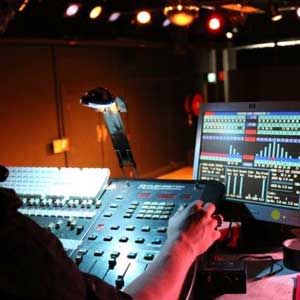For a medium that has been described as ‘dying’ for years, Theatre seems to be doing extremely well with a record 13.3 million people attending Broadway pro-ductions over the 2015–16 season, according to the Broadway League. It appears that we still crave the live experience of storytelling and enjoy the unique experience with the performer.

However, Technology has forced this age old entertainment to adapt in many aspects including the production, distribution and marketing.
Digital Performance
Theatres across the world have begun to embrace these new changes in technology incorporating them into their productions. In Timothy Birds production of Pippin, he integrated a computer-generated avatar sword-fighting an actor live on stage, merging the elements of reality and technology. On the stage of Sunday in the Park with George, the audience watched a Seurat painting gradually come to life in the show which cemented Knifedge’s reputation gaining an Olivier award for Best Set Design in 2007. Although changes such as these are often met with backlash, it is hard to argue against the fact that technology allows directors to take creative risks that more and more can be seen to be paying off.
Stage Management
Managing a production of any size can be a demanding yet rewarding task, overseeing the crew and organising the stage production. With the addition of modern technology, stage managers are able to control and monitor the set with more ease than ever. However, with such innovative technology coming to the forefront of modern theatre, we are now seeing more complex and elaborate sets adding to the difficulty of the stage managers role. Nevertheless, if a stage manager has the necessary skills to manage such an intricate and technologically advanced set, then this can elevate the performance and atmosphere of a whole production.

Live Streamed Productions
With the addition of live streaming technology and advances in visual and audio setups, we have seen the audience of productions widened through live broadcasts. Not only are many theatre performances now being broadcast live to cinemas, but we have also seen the addition of worldwide-televised live theatre performances such as Grease. Although there are arguments that these live streamed productions mean that actors perform less plays, it is also apparent that these live productions are increasing peoples desire to watch the play in person thus furthermore expanding the need for theatre productions.
Technology is ever changing, and the world is ever changing with it. Theatre is a prime example of how technology can have both negative and positive impacts, although we believe that it is how you use the technology to expand your opportunities within theatre that makes the difference.
We here at the Academy of Film, Theatre and Television think it is important to explore how technology and the cross disciplinary collaborations between film makers, cinematographers and theatre production teams can meet the requirements of the contemporary theatre industry.
Find out more about some of our courses; Musical Theatre, Live Production and Service Management, Acting for Stage and Screen or Enquire now.